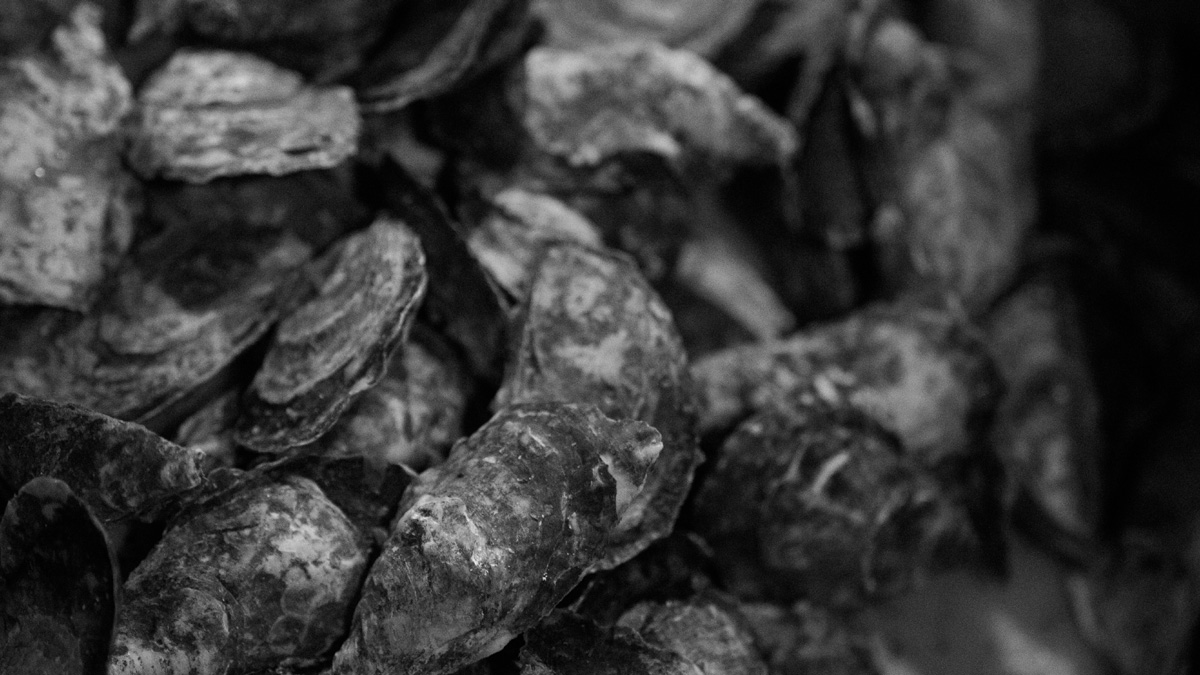 Rosty Soroka
Rosty SorokaConsider the oyster: as food, it’s a historical delicacy consisting of a small round of meat between two calcified shells often slurped down raw; as a symbol of luxury, it’s the sole natural producer of pearls. They’re often only served in what you might call fancy restaurants, because that’s the environment befitting most oyster consumption. Everything about oysters screams high class. They’re not a food that’s accessible to everyone by a long shot.
Oysters, like fine wine, have a highly developed culture built around them. There are dozens of varieties and flavour profiles and quality markers; there are east and west coast oyster fanatics; there are raw oyster bars and professional shuckers and detailed forum posts about the notes of varieties of oyster liqueur, the fluid inside the shucked shell of an oyster that rests below the meat when it’s been opened or “shucked.” There are oyster connoisseurs and food blogs that specialize in unpacking their briny goodness.
Another similarity between wine and oyster connoisseurs is the price point. Oysters are known to be an expensive food — a dozen of the bivalve mollusks can cost you upwards of 20 or 30 dollars depending on the variety.
But as there are cheap wines, there are also cheap oysters. The difference here is that across the board, oysters aren’t as well-understood as their fermented grape juice counterparts — and that’s where things can start to get murky.
Because oysters are fairly expensive at full price, promotions on oysters are common. The most widely known promotion in North America is known as “buck-a-shuck,” which offers discounted rates for each “shuck” — each oyster prepared for consumption. Oysters, as premium foodstuffs, can fetch prices up to $100 each for ultra-exclusive Coffin Bay King Oysters; typical East and West Coast oysters are closer to about three dollars apiece. Buck-a-shuck can take that down to about 70 per cent — or less — of the standard full price.
Economically speaking, though, it’s hard to see how a restaurant could serve the same oysters as its regular nights at a steeply discounted rate and still stay financially afloat. And that’s precisely why most traditional buck-a-shuck-serving restaurants don’t do that: instead, they serve one or two varieties of cheaper oysters and calculate what price they can reasonably offer them at. Whether that’s through shucking in-house versus outsourcing to full-time shuckers or combining promotions with complementary alcoholic beverages, restaurants find ways to make buck-a-shuck nights viable.
But that raises other questions about the quality of these cheaper oysters, the skills of the shuckers, and the effect all this has on the consumer experience.
“The first thing we can start with is the biology of an oyster,” says Simon-Luc Noël, a marine biologist and science facilitator at Science World in Vancouver. “The thing about all bivalves is that they’re fairly easy to grow, so they can be farmed really easily. But the problem with them, and the thing that everyone is really afraid of right now, has to do with (oyster agriculture): when you look at the oyster shell, it’s a craggy sort of thing. Part of the reason why it’s like that is because it’s made of calcium carbonate. People are afraid that with the changing climate and the dissolution of more carbon dioxide in water, what will happen is that it’s going to shift the balance of carbonate in a way that will make oysters harder to grow. It’ll take oysters more energy to grow, and so you’ll have fewer (oysters), and they’ll be smaller.”
On top of shifting salt and calcium carbonate concentrations, another problem has to do with algal blooms, also known as eutrophication. The worst instance of this, where algae discolour the water around them, has its own special name: red tide.
“A red tide occurs when types of algae and harmful bacteria start growing like crazy in a certain area. It varies from year to year, but it’s been exacerbated by farming practices and run-off of nutrients. Eutrophication results in oxygen levels sinking down really low, which stunts the growth of anything growing in the water,” Noël says.
If red tides are occurring, that means trouble for oyster suppliers and their clients. Combined with how prices are made up for buck-a-shuck and the knowledge the consumer has of oysters in general, that can make a big difference in how customers react to buck-a-shuck promotions.
“Some shrimp can be farmed; some can’t. Some types of fish cannot be farmed; some can. Some people are unaware of how many different species of different seafood there are. So you have a public that is generally ignorant of seafood, and you can find in (the seafood industry) suppliers who take full advantage of that or is ignorant itself in understanding how ocean products are different from terrestrial foods.”
Maik Kecinski, an assistant professor at the University of Alberta working in resource economics and environmental sociology, agrees that information — namely what information the consumer knows and how much — plays a huge role in oyster consumption. In the case of the buck-a-shuck, knowledge about where oysters are from and how they provide certain environmental benefits might entice a consumer to buy, but revelations about the realities of oyster biology might not.
“People respond to information; they like information, so providing some information is a good thing,” Kecinski says. “(With information), people’s willingness to pay (for a product) goes up. But if you tell them too much about it, then they get freaked out.”
A consumer might like to hear that oysters help the environment and are a food that, in a strange way, gives back to the environment — but they do that by filtering up to 50 gallons of water each day, straining excess nutrients from agricultural run-off and manure out of the waters they’re grown in. Some people might be put off by such news once they know that like liver, oysters contain both the good and the bad of their surrounding environment.
“A lot of people have no idea that oysters filter and clean water,” Kecinski says.
The overall lack of information most people have about oysters means that there’s some leeway in how the changes in factors affecting oysters might impact sales. To a certain extent, the perception of oysters as a high class, premium food won’t really change regardless of how many red tides come in. A lot this has to do with how we as consumers see prices, deals, and the value of an expensive good.
“Most consumers probably infer that they’re getting a good deal, rather than that the oysters are lower quality. We have basic, quick decision rules that we learn from the marketplace and use (called heuristics), and one of the most basic of these is that ‘sale equals good,’” says Sarah Moore, a marketing professor at the Alberta School of Business. “If we think we’re getting a deal, we have a positive reaction and are more likely to buy.
The way consumers would respond to such promotions would depend on which of these rules comes to mind when they see the buck-a-shuck.”
Moore cautions against taking the positive effects of sale prices too far, though. “This relationship could go both ways — consumers have pre-existing attitudes toward establishments, and this will affect how they perceive promotions. But if somewhere always has oysters on sale and nowhere else does, then you might start to make assumptions about poor quality and decrease your attitude toward them,” she says.
To picture this whole debacle in a different light, Moore advises thinking of another beloved classic food deal: Wing Wednesdays.
“Most of these promotions are fairly standard, and happen once a week: Wednesday wings; Monday oysters. If that’s the case, then consumers come to expect those promotions, and take them as the norm — that is, they won’t make any inferences about (a restaurant); it is what it is, because that’s what happens on Mondays,” Moore says. “And if it’s a good enough deal, as with wing nights, people go with the full understanding that they’ll get smaller plates or sizes of wings than if they ordered them at full price — but that’s okay, because that’s how it is; everybody does it, and we’re okay with letting the restaurant share some of the ‘deal.’”
In line with these observations about consumer behaviour, Kecinski notes that, like most things in life, the price of oysters and the human response to price hikes and drops are really very complicated.
“A lot of things influence your willingness to pay for an oyster — that’s true for any consumer good. (One factor is that) oysters have become a pretty popular good with the younger crowd, too — it makes (oysters) a cool, hip product, which drives up price. And in Edmonton, since there are so few places to get oysters, who knows — maybe the demand is just there (regardless of price changes),” Kecinski says.
Despite the oceanic challenges with changing salt lines and different carbonate balances, oyster agriculture is skyrocketing and the oyster market is growing exponentially. With all this expansion, are the issues with quality and the image of “spitting out Tabasco-flavoured bits of shell while some sophomore nervously bloodies himself with a shucking knife,” as a 2016 article by popular food site MUNCHIES puts it, really a huge problem? And, if not, how are these vendors disrupting the perception that buck-a-shuck is rife with subpar oysters and bloody, inexperienced shuckers?
Nick Krudo, co-owner of downtown Edmonton’s Black Pearl Seafood Bar, says it’s really about quality, integrity, and putting those values above the goal to make a quick buck (pun intended). “I never keep my (oyster) stock longer than seven days,” he says.
“Oysters can stay good up to 18 days, but I never have mine around that long, and we shuck them to order. Part of that is due to the Tuesday buck-a-shuck night (at Black Pearl), which because of the red tide on the West Coast, is now really two bucks-a-shuck night because we serve only premium East Coast oysters. East Coast (oysters) don’t carry red tide at all, and they don’t carry the infection that can come with red tide.”
“It’s not a money-maker for me, per se, and I don’t think that’s the case for anybody doing buck-a-shuck,” Krudo says. “Normally we sell our oysters for three dollars each, so you get a discount. We don’t necessarily see a money gain, but it does ensure stock is always fresh and makes sure the customer can get a decently priced oyster.”
For Mike Doppler, former executive chef of Edmonton’s Von’s Steakhouse and Oyster Bar, that’s an experience consistent with Edmonton’s only other buck-a-shuck establishment. “(Buck-a-shuck) does turn over stock. And when you’re dealing with highly volatile stock like live oysters, you want to move them as fast as you can,” he says.
There is a bundling effect that comes into play as well. “If I can get you into (a restaurant) with the idea that you’re going to buy six oysters for six dollars, you’re also going to buy a six-dollar beer (or) an eight-dollar glass of wine,” Doppler says.
For Black Pearl, Krudo estimates there’s about a 30 to 40 per cent increase in oyster orders on the restaurant’s buck-a-shuck night compared to other days of the week, but he also points out that Black Pearl’s not just about raw oysters. The restaurant serves lobster, crab, mussels, scallops, and myriad eclectic dishes that incorporate different curing and seasoning techniques for seafood. Because of that, Black Pearl doesn’t necessarily live and die by its raw oyster deals like some oyster bars, which he remarks is where a lot of the bad stereotypes about buck-a-shuck promotions originate from.
As for shucking, Krudo says it’s really about trial and error. “You need to know what you’re doing so you don’t hurt your hand or shred the oyster shell, and there’s a proper way of (shucking). But it’s about teaching it — really, anybody with knife skills can pick it up,” he says. “My wife, for instance, can shuck faster than anybody else.
But we’ll have little competitions between each other, for instance, to bring up (the team’s) speed. But we do a lot of testing the market, testing methods, and see what works.”
Doppler agrees. “Anybody could be trained to (shuck oysters),” he says. “Unfortunately the old saying, ‘practice makes perfect’ — that’s what it is. It’s about repetition and muscle memory, and then it becomes automatic. For the average cook, it would probably take them two or three months to get efficient at (shucking), and that’s at doing about 20 to 40 dozen (oysters) a day.”
By ensuring that shucking is done properly, supply is fresh and quickly turned over, and priority is placed on stock quality, Edmonton’s oyster restaurants manage to avoid the oft-lamented pitfalls of subpar buck-a-shucks.
“With increasing acidification, oyster prices are going to go up with time. At this point, it’s inevitable,” Noël says. “But if you aren’t seeing those problems in the supply and marketing chain, buck-a-shucks aren’t so bad.”




